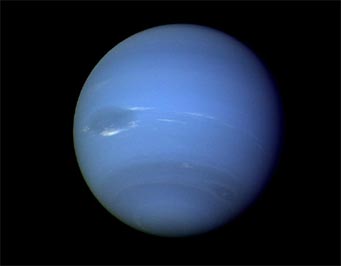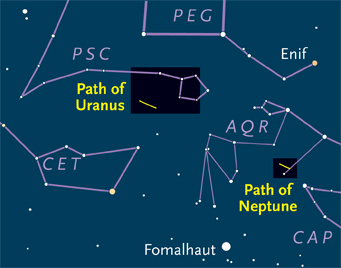On July 12th, Neptune completed one full circuit around the Sun since its discovery on the night of Sept 23-24, 1846.

Voyager 2 imaged Neptune when it flew by in August 1989. Methane gas, which preferentially absorbs red light, causes the blue hue. The dark spot in the middle is a cyclonic storm as wide as Earth.
NASA / JPL
Neptune's discovery is one of the most remarkable stories in astronomy history. The planet's existence had been predicted due to its gravitational perturbation of Uranus's orbit, and Neptune was actually found just a degree from its predicted position. But it turns out that this remarkable accuracy was due, in some sense, to luck as much as skill. You can read the whole story in our July issue.
This is an awkward time to observe Neptune; it doesn't reach a reasonable height above the horizon until the wee hours of the morning. Moreover, it won't appear anywhere near its discovery position with respect to the stars, due to the fact that Earth is in quite a different part of its orbit. But if you want to view Neptune anyway, it's easy to do with decent telescopes and binoculars. You will need a good planetarium program or our online observing guide and charts.

S&T diagram
Neptune is well-placed in the early evening sky starting in September, and it will appear extremely close to its discovery position among the stars from mid-October through December.
Thanks to "Bob D" for pointing out in a comment to a different online story that an argument can be made that Monday, rather than Tuesday, is Neptune's true birthday. According to Bob (I haven't checked the calculation), Monday is when Neptune is in its discovery position relative to the solar system's center of mass, which actually lies near but not at the center of the Sun.
When will Neptune really be at its discovery position in space? According to the Theory of Relativity, that's not a well-defined question. But Neptune will never again come anywhere close to its discovery position with respect to the average position of extremely distant galaxies, the closest thing we have to "absolute" position. That's because the Sun has been swept along in its rotation around the galaxy, and the galaxy has moved in its orbit around the center of the Virgo Supercluster.
 9
9









Comments
Bob D
July 8, 2011 at 1:51 pm
Thanks Tony 🙂 Re final paragraph: doesn't the ICRS just go wherever the Solar System goes? I believe they're the same as the coordinates I used. http://bit.ly/neptuneorbit
You must be logged in to post a comment.
Anthony Barreiro
July 8, 2011 at 2:51 pm
I thought I was going to read a happy little post about Neptune completing one orbit since discovery, and unwitting got sucked into a long but fascinating USNO essay about the International Celestial Reference System. There went my lunch hour! It seems to me that we will never be able to describe the universe with perfect precision. As we develop better metrics we merely discover ever finer sources of random variation, e.g. if you stare at the center of a quasar billions of light years away for long enough, it will move around a little bit. Who knew? It's still a worthy undertaking, but we need to remember that the total volume of our ignorance expands by a factor greater than 1 relative to the total volume of our understanding.
You must be logged in to post a comment.
Richard foley
July 8, 2011 at 6:32 pm
I am knew at this ( c in astronomy in college 30 years ago). Now I'm back that's a long orbit!!! In theory coudnt there still be some on lts say an orbit around the sun of letscsay 500 years that for whatever reason we haven't picked up.
You must be logged in to post a comment.
Anthony Barreiro
July 10, 2011 at 9:28 am
In response to Richard Foley's question, Neptune is the final *planet* to complete one orbit since discovery. Current astronomical nomenclature identifies only Mercury, Venus, Earth, Mars, Jupiter, Saturn, Uranus, and Neptune as planets. Pluto, Eris, and the other distant Kuiper Belt Objects have very long orbits in the hundreds of years; hopefully our descendants will be celebrating their birthdays. But they are all classified as *dwarf planets*.
You must be logged in to post a comment.
Tony Flanders
July 10, 2011 at 1:31 pm
In fact, Eris, the largest known object in the solar system that isn't classified as a planet, has a 550-year orbital period. However, nothing anywhere near Earth's size -- let alone Neptunes -- could possibly be that close, or surveys would have picked it up. How about more distant orbits? It's impossible to rule out the existence of a Neptune-sized body that's 20 times more distant than Neptune -- but almost every planetary scientist would bet against it.
You must be logged in to post a comment.
Glenn Miller
July 12, 2011 at 12:25 am
The statement in the last paragraph that “Neptune will never again come anywhere close to its discovery position with respect to the average position of extremely distant galaxies” concerns me. According to JPL’s Horizons ephemeris Neptune has the following ICRF (J2000.0) R.A. / Decl.(* = degrees):
1846-Sep-23, 23:06 UT (near midnight in Berlin on Sep-24) …
22h 01m 30.93s / -12* 40’ 20.1’’
2011-Nov-22, 14:03 UT …
22h 01m 31.64s / -12* 40’ 48.5’’
The angular separation between these two coordinates is only 0.5 arcminutes by my calculation, which seems very close!
You must be logged in to post a comment.
Bob D
July 12, 2011 at 5:10 am
Glenn, the R.A./Decl values you've given represent the location of Neptune in the sky, relative to the international celestial reference frame, as viewed from the Earth. Neptune will certainly come close to that location in our skies again, but in the meantime the Earth is in a different position relative to the Sun, even the Sun is in a different position relative to the centre of the Solar System about which Neptune orbits, the Solar System is in a different point on its trajectory around the galaxy, etc. Relative to the average position of extremely distant galaxies (or, equivalently, relative to the CMB reference frame) the Solar System is moving at 370km/s towards a point in the constellation of Leo, not far from the ecliptic - so the plane of rotation of the Solar System is slicing through the CMB like a frisbee, with its centre travelling at nearly 70 times faster than the orbital speed of Neptune. That's why Neptune won't be back to where it was at the time of its discovery. (But as Tony says, given the principle of relativity, the concept of an absolute reference frame is empty anyway.)
You must be logged in to post a comment.
Dileep V. Sathe
July 12, 2011 at 3:30 pm
Galileo Galilie's observation:- Every one knows how difficult it is to see planets of our solar system, beyond Saturn. This difficulty prevented him from discovering Neptune because it was changing from forward motion to "retrograde" motion between 28 December 1612 and 27 January 1613 - and hence was judged as a fixed star by him. In a sense, our solar system is a "troubling" one as it does not contain any real-retrograde planet but does have retrograde moons around Jupiter, Saturn - discovered 100 years ago. It troubled not only Galileo Galilie in the past but is causing "conceptual" touble for learning "O" / H.S.C. level physics also. Write me on [email protected] for more information.
You must be logged in to post a comment.
Alain Maury
July 12, 2011 at 4:56 pm
The Nov. 4th 2010 occultation of a star by Eris has shown it to be slightly smaller than Pluto. So Pluto is the largest asteroid in the solar system, not Eris.
You must be logged in to post a comment.
You must be logged in to post a comment.